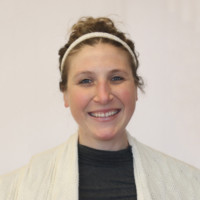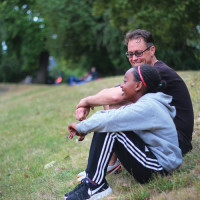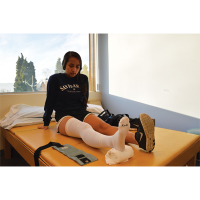
Standing in the main hallway of da Vinci Arts Middle School, Kennedy Bryan-Hart looked up and saw her photograph hanging front and center in the doorway. Leading up to the event where all the eighth grade students at da Vinci showcased their art, Bryan-Hart had dreamed of her photograph being hung in a place for all to see.
Since her first class seven years ago at da Vinci, Bryan-Hart has fallen in love with photography. This passion helped her push through the challenge of being the only sixth grader in da Vinci’s photography class.
For Bryan-Hart, film photography is an art. “You can get so much higher contrast with it because it’s only two colors — black, white and then a grayscale,” she says. “It’s something that I know that I can always fall back on even if I take a break.”
Despite her devotion to photography, Bryan-Hart has never imagined it being her profession. For her, it is simply an activity that keeps her grounded and allows her to focus on herself. She enjoys being able to follow her own artistic direction, and not be constrained by anyone else’s vision.
“It’s hard to differentiate yourself from everybody else,” she says. “I feel like if I were to try and do this as a career it would be hard to be successful because I kind of just do it for me. I don’t do it for anybody else … It’s something that just alleviates all the pressure of everything else I have to deal with. It’s nice to have photography, where I can just chill and go into the zone.”
Coming into high school, the structure of her photography classes changed. Bryan-Hart remembers making photos of whatever she wanted to in middle school. But in her first year at Grant, her photography class had specific assignments which frustrated her. She felt as though she was back to the basics, despite her previous experience with photography.
Bryan-Hart struggled with the more rigid structure of the class. But she soon realized that the advice of her teacher, Cristy McCarty, was more helpful than anything else.
“(McCarty’s) projects have helped me grow as a photographer more than when I was in middle school,” says Bryan-Hart. “(Her lessons) are a lot more about growing technique.”
As one of the few sophomores in the Intermediate/Advanced Photography class, Bryan-Hart tended to compare her work to that of more experienced and older students. But she quickly learned what she had to do to improve.
“The only way that I’m going to get better (at photography) is not to worry about whatever (others are) doing and what they think of what I’m doing,” says Bryan-Hart. “I just have to focus on me.”
Because film photography hasn’t changed much over the last few decades, Bryan-Hart is able to connect with older generations over the medium. Last year when she volunteered at the Hollywood Senior Center, she was able to have in-depth conversations with the residents about the art form that they love.
She especially remembers having trouble connecting with one older man until she mentioned that she did film photography. “When I said ‘film,’ he was freaking out,” she says. “He was like ‘that’s my favorite thing … I did that for like 60 years.’ So then we had something to talk about.”
McCarty and Bryan-Hart have now worked together to create a course of independent study for herself. “I found out that when I do whatever I want, I enjoy it a lot better and it doesn’t feel as much as a chore as the past couple years were,” says Bryan-Hart.
Previously, Bryan-Hart felt as though she was only going through the motions in her photography class, but with the independent study, Bryan-Hart feels much more happiness and freedom.
Despite encouragement from her mother to pursue photography as a career, Bryan-Hart says that is not why she continues to pursue it. “For me, it’s not really to showcase and display,” she says. “It’s something in my day that I can always look forward to.”
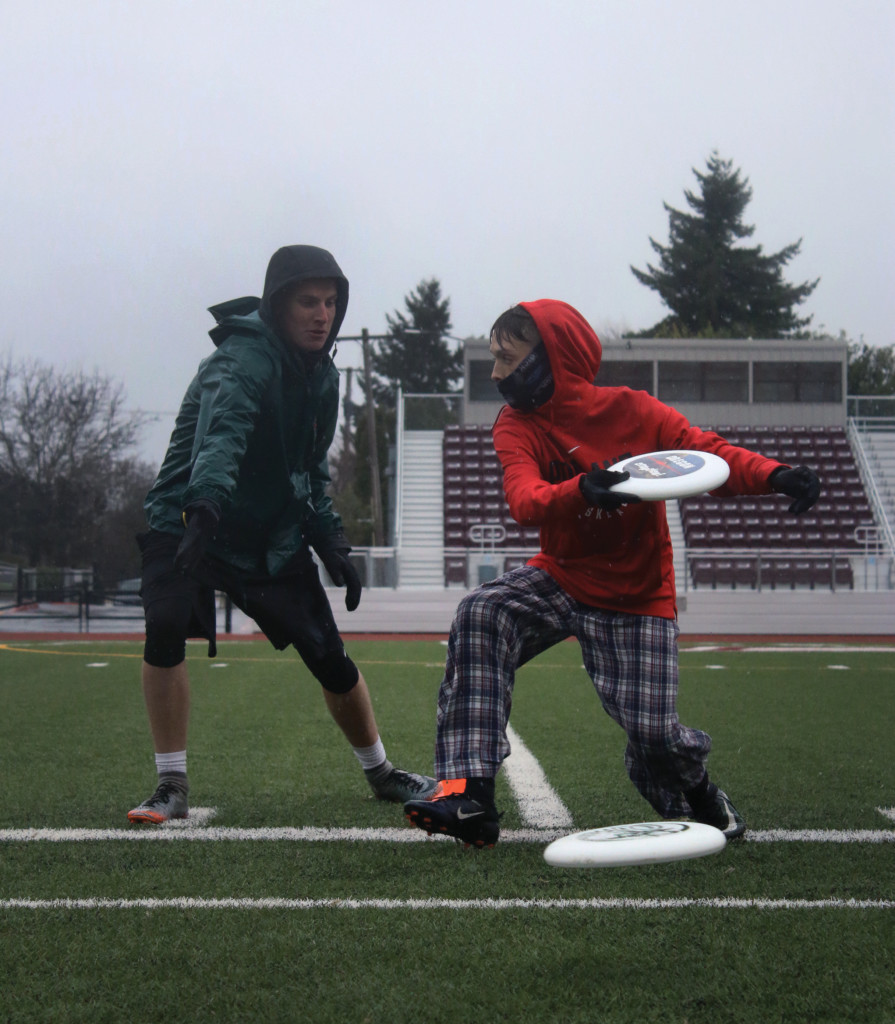
John Moore, sophomore
John Moore watched as the frisbee sailed over the defending team’s fingertips. Smiling as he ran back to his team’s end zone, he evaluated the strengths of the player defending him and started to plan what he could do to get an advantage. His mind raced as he did what he needed to do to push his team to success.
Through hours of practice, tournaments, and regular games, ultimate frisbee has become Moore’s passion.
At the age of 11, Moore was introduced to the sport by a teacher who was recruiting for ultimate frisbee teams. “I wasn’t playing a sport and I thought it sounded pretty interesting so I came to the first practice … and I just kind of fell in love with it,” he says. “(Ultimate frisbee) makes me happy because I like the feeling of getting better and improving. I like the feeling of competing at a high level against other high level teams. I really like my teammates … but mostly I just like to play.”
Throughout middle school, Moore often felt he was better than his teammates. But he recognizes that this attitude can be detrimental to an ultimate frisbee team because in order to score, players must pass to each other and work together. “A team can fall apart with a couple of bad spirited players,” he says.
When he was in eighth grade Moore discovered that tryouts would be held for a state youth ultimate frisbee team. This news flipped a switch in his head. The idea that all the work he put in could be rewarded with a national championship from the state team drove him to work harder and become the best player he could be.
He decided to put in the work needed to play at a higher level of the sport. “I started training a lot more, putting a lot more effort in when I did play, listening to my coaches, trying to become all around a more coachable player and a better teammate,” he says.
Moore’s dedication to becoming a better teammate has now led him to play for Oregon’s state team, comprised of the best high school players under seventeen.
Moore practices on Tuesdays, Thursdays and during the weekend with a team called the Waldorf Wolf Pack in Milwaukie, Oregon. He is also coaching a middle school team that recently went to Eugene and won a state title.
Through ultimate frisbee, Moore has also found a community of people that makes him happy to be around. “My teammates are some of my best friends,” says Moore. “(They) are some of my favorite people. The way the game is played, there is a certain amount of respect and spirit in it.”
For Moore, ultimate frisbee has given him a chance to grow into the leader that he has always wanted to be. “Playing has made me better, becoming better forced me to be a leader,” he says. “And becoming a leader turned me into a more driven, vocal and, at the same time, level-headed person.”
Ben Kress, sophomore
During an early morning sunrise, sophomore Ben Kress takes his dog for a walk before school. His breath comes out as white puffs in the frosty air.
Kress stops for a second to pull out his phone as his dog tugs impatiently on the leash. He snaps a photo of the sun rising between the trees, adding it to the collection of sunrise photos in his camera roll.
Being outside is an important part of Kress’s life. It gives him time to process whatever has happened in his day at school, and it gives him a place to be his true self.
“It’s nice to take it easy and have your mind off your life and your school and your social life and just (have) a place to feel calm,” says Kress. “I feel like I can express how I really feel when I’m on a hike. You don’t really pay attention to people around you, it’s just you and nature and the air and just what your thoughts are.”
Growing up, hikes in Forest Park or the Columbia River Gorge were a regular occurrence for Kress and his family. Kress grew to love the feeling of fresh air and being in nature.
Like many of his friends, Kress played soccer and enjoyed spending time outside. But on a field trip to Forest Park with his class in elementary school, Kress realized that there was so much more to appreciate about nature and the outdoors.
He discovered that being outside gave him an opportunity to explore and investigate the world around him. “The leaves were really colorful and vibrant, and I just remember walking through the valley with colorful trees all around us,” he says. “If you’re in nature, you get to discover new things and go new places.”
As Kress entered high school, the amount of homework he brought home on the weekends grew larger, making it more difficult for his family to leave the house for hikes.
While at times that was difficult for Kress, he was still able to spend time outside. “It affected my happiness less than I expected because I was still going outside and feeling the fresh air … but I couldn’t be out in the nature and the trees in the forest,” he says.
During spring, Kress’s mother makes sure to get them out and onto the trails, especially during long weekends. Without the regular family outings, Kress began to take his dog for walks more often. “I like the fresh air and the wind against my face,” he says. “I like the natural feeling because it’s different from the air conditioning.”
Being in the outdoors is crucial to Kress’ happiness, and he doesn’t want to lose his connection with nature. It’s become a place where he doesn’t have to worry about the world around him. “(It’s) time where you filter out all the bad stuff, restart, refresh,” he says.
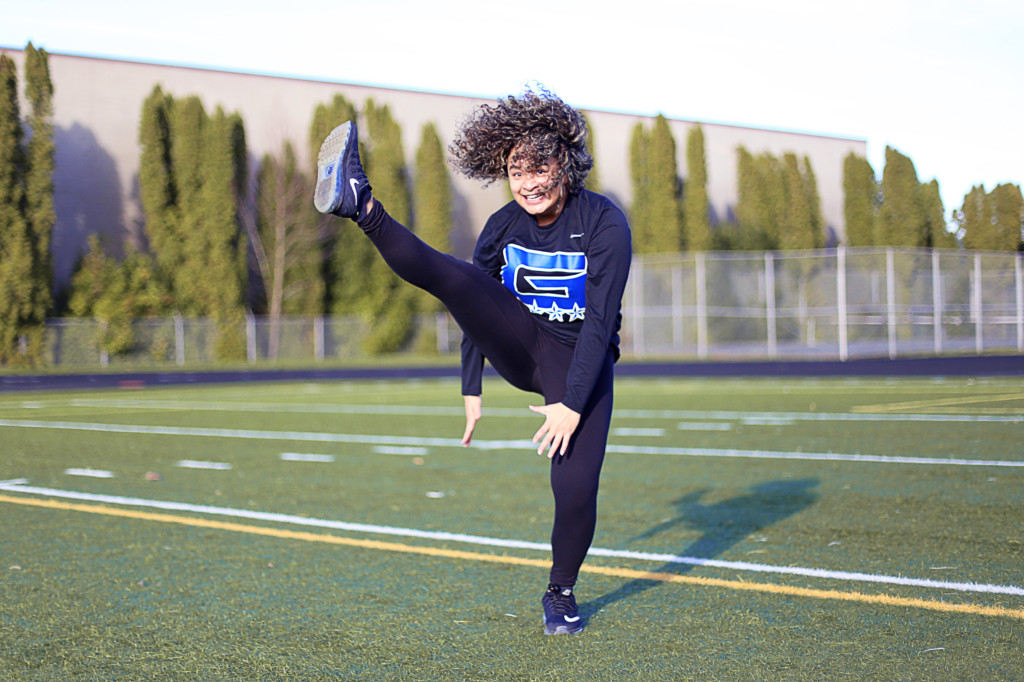
Amaya Aldridge, junior
It’s February 2017, and the then sophomore Amaya Aldridge eagerly waits to perform in the studio of KATU News “Afternoon Live.” She stands alongside her fellow members of Grant’s step team, Queens of Impact. They are there to step — “Step is a form of percussive dance where the entire body is used like an instrument to make complex beats through a mix of footsteps, spoken word, claps, and more,” she says.
Aldridge stood with her hands clasped behind her back as Tra’Renee Chambers, the host of Afternoon Live, introduced the group to viewers across the Portland metropolitan area. The team performed a step, and helped teach Chambers — a former stepper herself — a simple step.
After a video of the team performing for the first time at Grant’s Black History Month assembly was shared on Facebook earlier that month, they were invited to KATU to perform on live television.
For Aldridge, dance has been a part of her life since she was little, although the focus on step is more recent. “Dance makes me extremely happy—the training, the stretching and trying new things outside of my style,” she says.
As a third grader, Aldridge took hip-hop classes, but when she began to play basketball competitively, dance was pushed aside. Upon entering high school, she had the opportunity to begin dancing more frequently.
Even before she became a part of the dance program at Grant, Aldridge would watch the advanced dance performance class at assemblies. Watching other students dance helped her to realize how much she wanted to be performing with them.
In her sophomore year, Aldridge signed up for a beginning dance class to see what the program was like.
She quickly found that the dance program at Grant is a tightly knit community. “That class was like a family,” she says. “We were all really close by the end of the year. I was able to make a lot of friends out of it and I was kind of surprised by the connections I still have with the people in that class.”
But when Aldridge was introduced to the idea of stepping at the Black History Month assembly at Grant, it didn’t necessarily come easily to her, having never done the dance seriously before. “Once we got into it, it was really cool and I was excited for the school to see it, because there’s never really been something like this before at Grant,” says Aldridge.
For Aldridge step is important to more than just her happiness; she feels that step helps to showcase a long history of African culture that may not otherwise be apparent at a school like Grant. “I think it’s really important to show that history within assemblies or in any kind of performance,” she says. “I think it’s important to understand cultural appreciation and I think something step performances shows you is how to appreciate something that came from a really cool and rich history.”
However, Aldridge, who is now a junior, left the step team around the end of her first semester this year. Aldridge felt that she had overextended herself with extracurricular activities and needed to focus more on her academics.
“It’s something that makes me really really happy, and I love being a part of step and trying something that I’ve never tried before,” says Aldridge. “I had to step away and it made me sad but in the long run I think I made the best decision.”
Despite leaving the step team, Aldridge continues to be is still a part of the dance program at Grant, which has become a huge part of her life. Because she is no longer doing step, she has more time to focus on dance. “(Step is) kind of pushing me in my dance to try new styles and to try new things.”
Dance continues to play an important role in Aldridge’s overall happiness. It’s a creative and emotional outlet that she can’t get with any other activity. “It’s helped me calm down, I used my emotions through dance, ” she says. “It keeps my spirits up, and keeps me happy.”
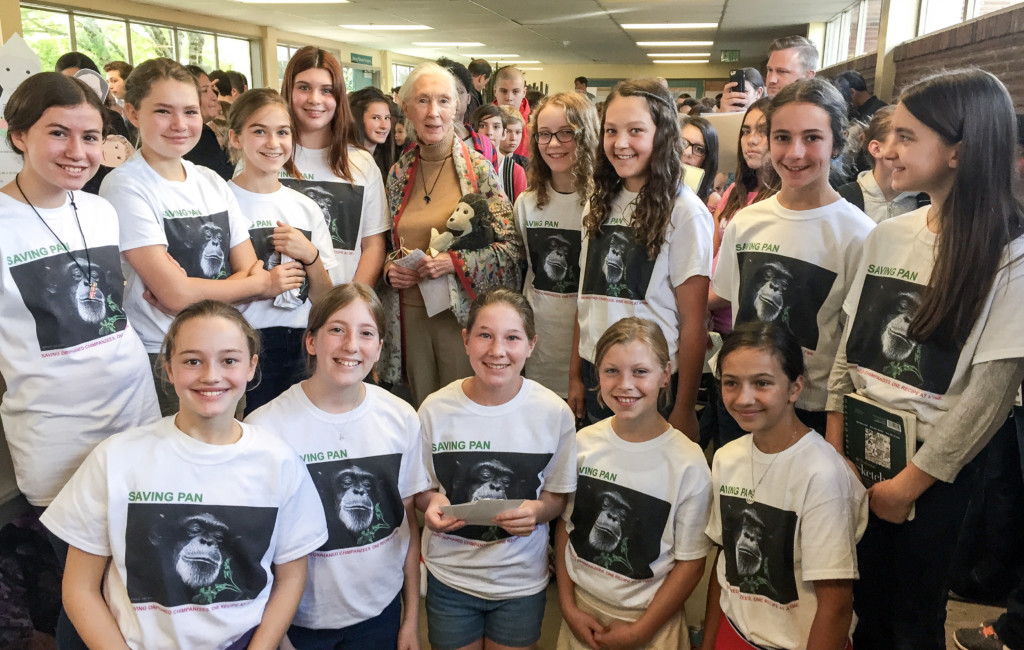
Brooke Abbruzzese, freshman
As 13 sixth graders stand around a dining table, they make a toast with sparkling apple cider to start off their weekly meeting. Brooke Abbruzzese, now a freshman at Grant, and 12 of her friends are hard at work on a cookbook of recipes collected from chefs around the world. The girls laugh as they begin to work on testing recipes that they have gathered for their cookbook, like a vegetable frittata and Moroccan chickpea soup.
Inspired by the idea to save chimpanzees, Abbruzzese and her friends set out to create a vegetarian cookbook. Their goal was to help put an end to the bushmeat trading that is common in many African countries. The trade of bushmeat – meat from non-domesticated animals in the wild – puts the population of many species in danger.
All the proceeds of their cookbook would go to the Tchimpounga Sanctuary, a sanctuary for chimpanzees orphaned because of the illegal bushmeat or pet animal trade, in the Democratic Republic of the Congo. The girls wrote letters and emails to famous chefs and soon recipes came flooding in from people like Michelle Obama, Jane Goodall and Michael Pollan, author of “Omnivore’s Dilemma.”
At first Abbruzzese had stood back and let her friends do the cooking, not trusting herself in the kitchen. But as the meetings continued, she soon found herself getting more involved.
Never having cooked much before, Abbruzzese decided to launch herself into the world of culinary arts. “I’ve definitely started to associate cooking with being happy,” she says. “It’s been something that I look forward to every Friday.”
Having the confidence to make changes to recipes, Abbruzzese experimented with her father’s hot chocolate recipe, adding ingredients like cinnamon, vanilla and mint, as well as switching the sugar out for honey. “I’ve become a better cook and I’ve been a lot more comfortable with messing around with spices and new flavors,” she says.
Her confidence in the kitchen has come from three years of working on a cookbook titled, “Saving Pan.”
Occasionally the chefs who sent them recipes would come to meetings to make food with the girls.
Abbruzzese fondly remembers the night that Heidi Lovig, from “Heidi Ho! Organics,” – a company that has a line of vegan “cheezes” – came to make her famous vegan macaroni and cheese with the group.
From a young age, Abbruzzese was inspired by the work of Jane Goodall and wanted to follow in the activist’s footsteps. Abbruzzese’s father began to help her brainstorm ideas that could help her give back.
Soon, Abbruzzese decided that it would be easier and more fun to work with others and began reaching out to her friends. After coming to the common goal of creating a project that would benefit the world, the idea of a cookbook was formed.
The girls joined the Roots and Shoots organization, Jane Goodall’s youth service program, and began to search for recipes. They found that many of the recipes collected from the chefs allowed people with other dietary restrictions to enjoy the food as well.
Abbruzzese, whose mother is lactose and gluten-intolerant, understands the need for accessible recipes. “I feel like I’ve kind of come to understand how difficult it is to cook for an entire family, especially a family with a lot of dietary needs,” says Abbruzzese. “There are definitely a lot of recipes in here I feel like accommodate for dietary restrictions.”
Abbruzzese says she has learned more than she could have ever imagined. “I think this is one of the more important pieces of my life for the past three years or so because I feel like I’ve learned a lot about how to cook, and I thought it was really cool to learn about the publishing process and things like food photography,” she says. “It also created this tight community of families. It was just a really good experience.”
Although Abbruzzese hasn’t thought much about future projects after publishing the cookbook, she and the rest of the group are dedicated to selling their cookbooks and trying to get the word out about the issue of bushmeat trade.
Because cooking is a valuable skill, Abbruzzese feels a lot more prepared to take on life, as she has grown from making boxed macaroni and cheese to creating a cookbook.
Cooking has become something that Abbruzzese treasures. It reminds her of nights in the kitchen with her close friends, laughing and eating delicious food. “When I think of cooking I think of the cookbook, and when I think of the cookbook I think of community and awareness,” she says. “It’s just kind of a warm feeling.”

